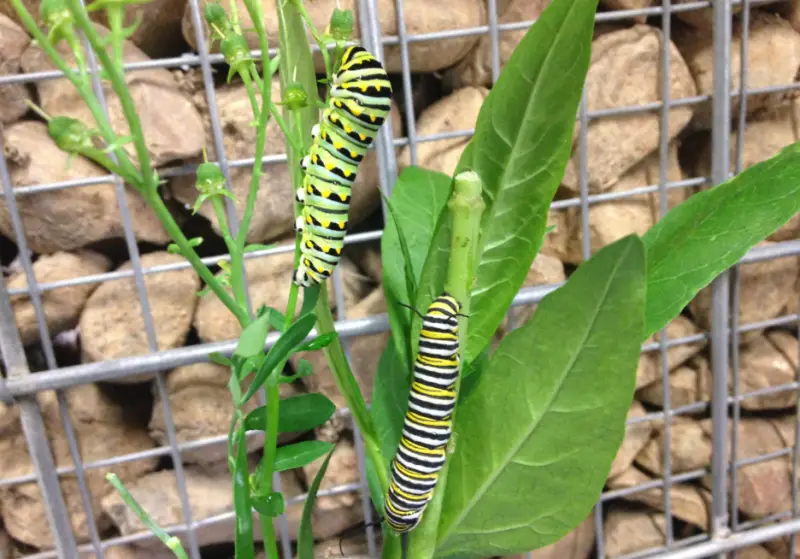Swallowtail caterpillars are captivating creatures that transform into beautiful butterflies. If you’re interested in raising them at home, you’re in for a fascinating journey! This Swallowtail Caterpillar Care Guide will provide all the essential information you need, from creating the perfect environment and providing the right food to handling each stage of their growth.
Whether you’re a beginner or have some experience with caterpillars, this guide will ensure you have a successful and rewarding experience raising swallowtail caterpillars.
Overview of Swallowtail Caterpillars

Swallowtail caterpillars are the larvae of swallowtail butterflies, a group of large, colorful butterflies in the Papilionidae family. They are found worldwide and include a variety of species, such as the Eastern Black Swallowtail (Papilio polyxenes) and the Tiger Swallowtail (Papilio glaucus). Each species has unique characteristics, but all share some similar care requirements during the caterpillar stage.
- Common Name: Swallowtail caterpillar
- Species Examples: Eastern Black Swallowtail, Tiger Swallowtail
- Family: Papilionidae
- Life Cycle: Egg, Caterpillar (Larva), Chrysalis (Pupa), Butterfly
- Diet: Primarily feeds on host plants such as parsley, fennel, and dill
- Habitat: Gardens, meadows, fields, and other areas with host plants
Identifying Swallowtail Caterpillars
One of the first steps in caring for swallowtail caterpillars is ensuring accurate identification. Each species of swallowtail has distinct markings, but they generally have vibrant green or black bodies with various stripes or spots. The Eastern Black Swallowtail caterpillar is green with black bands and yellow dots, resembling a small snake as a defense mechanism. These markings are helpful to identify the caterpillar and determine its specific needs.
Setting Up a Habitat for Swallowtail Caterpillars
Creating a comfortable and suitable habitat is essential for raising swallowtail caterpillars successfully. Here’s what you’ll need:
- Container: A clean, ventilated container with a secure lid is ideal. Clear plastic or glass containers work well because they allow you to observe the caterpillars. Ensure the container has small ventilation holes to keep the airflow fresh.
- Substrate: Place a layer of paper towels or a cloth at the bottom to absorb any moisture or droppings. Clean the substrate regularly to maintain a healthy environment.
- Host Plants: Swallowtail caterpillars are host-specific, which means they primarily eat plants in the Apiaceae family (parsley, dill, fennel, and carrots). Place a fresh cutting of the host plant in a water tube or vase to prevent wilting and make sure it stays fresh.
- Humidity and Temperature: Swallowtail caterpillars thrive at room temperature (65-75°F or 18-24°C) and moderate humidity. Avoid placing the container in direct sunlight, which can cause overheating.
- Clean Environment: Keep the habitat clean by removing droppings (known as frass) daily and replacing any wilted plants. A clean environment reduces the risk of mold or bacterial growth, keeping your caterpillars healthy.
Feeding Swallowtail Caterpillars
Diet is one of the most critical aspects of swallowtail caterpillar care. These caterpillars are herbivores, meaning they only eat plants. However, they are quite particular about their food. They rely on host plants, and each species may prefer specific plants. Here’s a quick guide to their dietary needs:
- Eastern Black Swallowtail: Prefers parsley, dill, fennel, and occasionally carrot tops.
- Tiger Swallowtail: Typically feeds on tulip tree leaves, cherry leaves, and occasionally birch leaves.
Important Feeding Tips:
- Consistency: Keep fresh host plants available at all times. As the caterpillars grow, they’ll eat more, so replenish food frequently.
- Quality: Avoid feeding caterpillars plants treated with pesticides or chemicals. Organic or garden-grown herbs are ideal.
- Water Needs: Swallowtail caterpillars obtain most of their moisture from their host plants. If the leaves are wilting quickly, try placing the stems in a small water tube to keep them fresh.
Managing the Growth Stages of Swallowtail Caterpillars
Swallowtail caterpillars go through several instars (growth stages) before they become chrysalises. Each instar is marked by a shed of their skin as they grow larger. Here’s a breakdown of the key stages:
- First Instar: The caterpillar hatches as a tiny, black caterpillar. It often has white spots, which help it blend in with bird droppings as a defense mechanism.
- Second and Third Instars: As it grows, it sheds its skin and begins to show the characteristic green color (in species like the Eastern Black Swallowtail).
- Fourth and Fifth Instars: The caterpillar is now fully grown and displays vibrant colors. It will continue to eat voraciously in preparation for the chrysalis stage.
Preparing for the Chrysalis Stage
Once the caterpillar has completed its growth, it will stop eating and look for a place to form its chrysalis. During this time, you can make a few adjustments to help it transition smoothly:
- Add a Stick or Branch: Provide a stable stick or branch within the habitat where the caterpillar can attach itself. It will anchor to this spot using silk.
- Watch for Changes in Behavior: When a caterpillar is ready to pupate, it will typically climb to a higher spot, anchor itself with a silk pad, and form a “J” shape as it prepares to molt one final time.
- Provide a Quiet Environment: Avoid moving or disturbing the container during this period. It’s essential to keep the environment stable so that the caterpillar can safely form its chrysalis.
Overwintering the Chrysalis (If Needed)
In some cases, if the caterpillar enters the chrysalis stage late in the season, it may overwinter in the chrysalis until spring. For successful overwintering of swallowtail chrysalises:
- Cool Environment: Place the chrysalis in a cool, sheltered area, such as an unheated garage or basement, where temperatures stay between 35-50°F (1-10°C).
- Minimal Disturbance: Don’t handle or move the chrysalis frequently, as this can disrupt its development.
- Spring Awakening: When temperatures begin to warm in spring, the butterfly will emerge. Move the container to a warmer area as temperatures rise.
Common Challenges and Solutions
While raising swallowtail caterpillars can be rewarding, a few common issues may arise:
- Pesticides on Host Plants: Always verify that host plants haven’t been treated with pesticides. Even a small amount can be harmful or fatal to caterpillars.
- Mold in the Habitat: Moist environments can cause mold to develop, especially if frass isn’t removed. Clean the container regularly and ensure good airflow.
- Predators: If you’re raising caterpillars outdoors, beware of natural predators, such as birds and spiders. Indoors, use a secure container with ventilation.
- Failure to Pupate: If a caterpillar doesn’t pupate, it may be due to environmental stress or illness. Ensure optimal conditions for temperature, humidity, and cleanliness.
Releasing the Butterfly
Once the butterfly emerges from the chrysalis, it’s time to release it into the wild. Here are a few tips to make this moment as smooth as possible:
- Wait a Few Hours: Allow the butterfly a few hours to rest after emerging so it can strengthen its wings.
- Choose a Mild Day: Avoid releasing the butterfly in extreme weather, such as heavy rain or high winds.
- Select a Flower-Rich Area: Release your butterfly in a location with plenty of nectar-rich flowers, such as native wildflowers or butterfly-friendly gardens.
Final Tips for Raising Swallowtail Caterpillars Successfully
By following this Swallowtail Caterpillar Care Guide, you’re well on your way to a successful and enriching experience. Here’s a quick recap of the key points:
- Identify the species correctly to provide the right host plants.
- Create a safe habitat with fresh plants and proper ventilation.
- Monitor the growth stages closely and provide adequate food.
- Avoid pesticides and clean the habitat regularly to prevent disease.
- Prepare for the chrysalis stage with branches for support.
With these ultimate tips, raising swallowtail caterpillars from tiny larvae to beautiful butterflies can be a wonderful learning experience, bringing you closer to nature’s incredible life cycles. Enjoy watching these fascinating creatures grow and transform, knowing you’ve contributed to their journey from caterpillar to butterfly.






